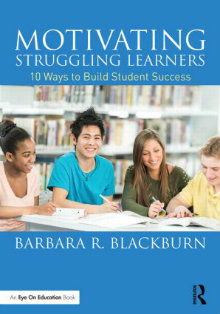Motivating Struggling Learners for Success
Motivating Struggling Learners: 10 Ways to Build Student Success
By Barbara R. Blackburn
(Routledge/Eye on Education, 2016 – Learn more)

While most of Barbara Blackburn’s books focus on rigor, it is hard to have successful rigorous instruction if young people are not motivated to learn, as is true of many of our struggling students.
In the Introduction (p. xv) to her latest book, Motivating Struggling Learners, Blackburn notes that “87% of educators believe that student engagement and motivation are very important to student achievement . . .” but that only 19% of educators are confident that they have the strategies they need when students are not engaged or motivated.
She also notes that all students have motivation; it’s just that some of them – especially those who struggle in school– are just not naturally motivated by the experience of school. In this book, Blackburn’s goal is to translate the research and her own experiences into stories and strategies that teachers can easily employ to get students to turn their motivation toward school and therefore increase their academic success.
A thorough look at factors

Blackburn’s final chapter specifically addresses strategies for working with several categories of diverse learners, such as those who are second language learners and those with disabilities such as autism or learning disorders.
The book is easy to use as most of the strategies, graphic organizers, and key reflective questions are boxed off within the text, for future reference. Some materials are also available online as eResources (although there were a number of others mentioned in the book that I would like to have digital access to).
What stands out to me
First, I appreciate the boxes with the reflective questions and strategies, which I can easily go back to for ready use as needed, including guides to help teachers pinpoint materials to keep students in the zone of proximal development (where they learn the most), strategies to combat learned helplessness, and 10 steps to building resilience.
Another real favorite of mine is how, throughout the book, Blackburn continues to point out very subtle, unintentional things that we say or do that contradict our “official” words and tell students that we don’t believe in them – things like calling on them less, using comfort talk instead of motivational talk, and displaying work in the room that focuses on perfection rather than growth.
My most favorite idea of all is the story of the “Blue Ribbon Ceremony,” found in the beginning of the praise and feedback chapter (p. 25-26). Blackburn tells a compelling story (which I won’t give away here), about empowering students with the “Who I Am Makes a Difference Ceremony” where she tells each student of their worth and then sends them out to pass it along with blue ribbons. The rest of the story I will leave for you to read for yourself, but it is definitely my favorite.
Blackburn has done a good job of providing easily executable concrete examples, stories and strategies that we can employ to help our students become more motivated, connected and successful in school. Definitely worth the read!
Dr. Laura Von Staden is a Special Education Middle School Teacher in Tampa, Florida. She serves on numerous committees both at her school and within her district and works closely with the local university where she is a Professional Practice Partner and a master mentor. Dr. Von Staden also facilitates both online and face-to-face Professional Development for her school district.


































